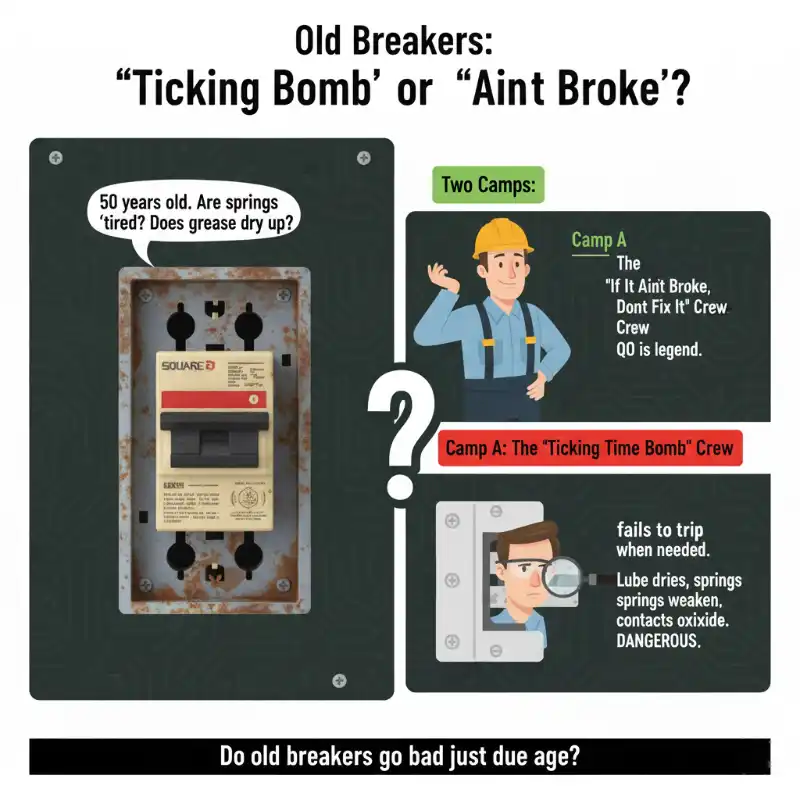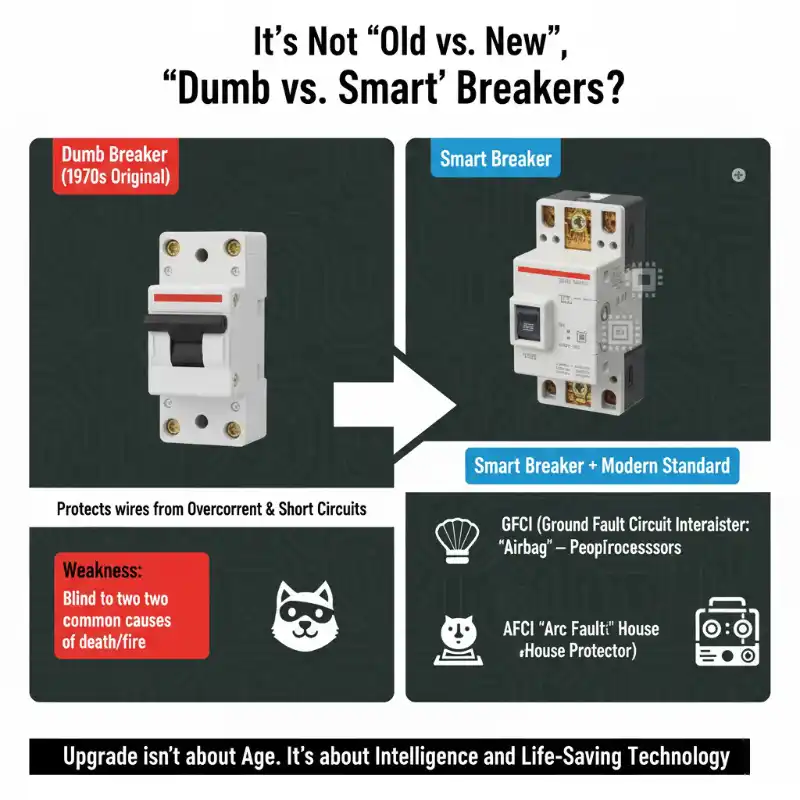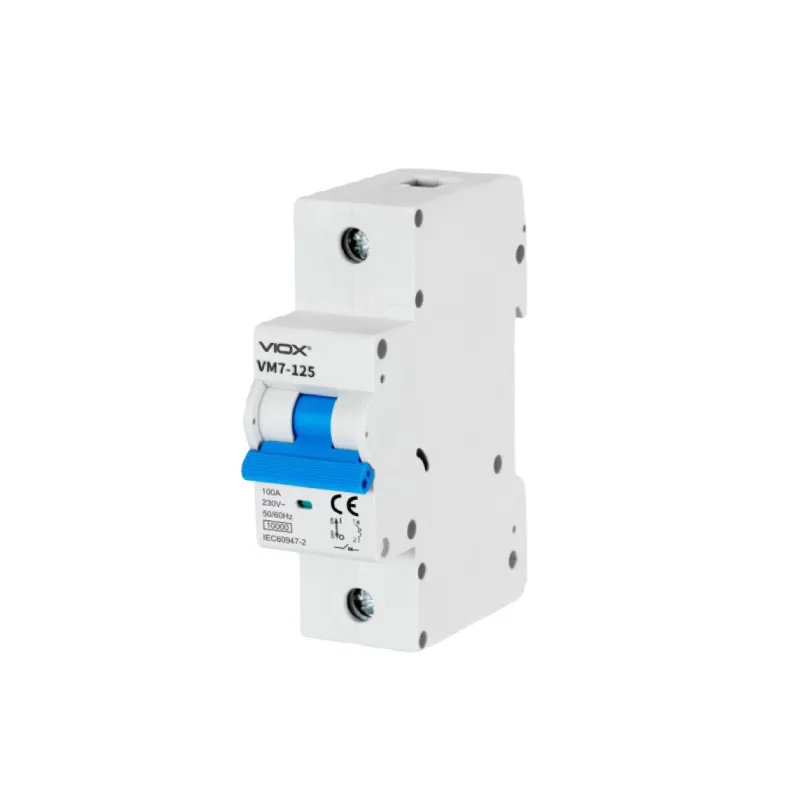Your house is 50 years old. You pop the cover on your electrical panel, and you see a full rack of Square D QO breakers—the workhorses. They’ve been there since the house was built. They’re old.
And that gets you thinking. “This is a mechanical device. It’s got springs. Do springs get ‘tired’ after 50 years? Does the grease dry up? Do I need to replace these just because of their age?”
This is one of my favorite questions. It’s logical, it’s responsible, and it lands right in the middle of a “grey area” that separates “thrifty” from “dangerous.”
It also sparks one of the biggest debates in our industry. And I’ll let you in on a secret: you’re almost asking the right question.
First, let’s look at the “age” debate, and then I’ll show you the nyata question you should be asking.
1. The “Ticking Bomb” vs. “Ain’t Broke” Debate
When you ask, “Do old breakers go bad?” you’ll get two answers from two different camps.
Camp A: The “If It Ain’t Broke, Don’t Fix It” Crew
This camp says a breaker is a passive device. It’s not a spinning motor. It just sits there. As long as it’s never been drowned in a flood, isn’t visibly corroded, and hasn’t been “exercised” to death, it’s just as good as it was 50 years ago. That Square D QO, in particular, is a legend. It’ll probably outlive us all.
Camp B: The “Ticking Time Bomb” Crew
This camp (which includes me, most days) will tell you that “ain’t broke” is a dangerously ignorant philosophy for a life-safety device.
Why? Because a “broken” breaker doesn’t mean “the lights won’t turn on.”
A “broken” breaker means “it fails to trip when it’s supposed to.”
Inside that 50-year-old box, the factory-applied lubricant has dried to a sticky wax. The springs have been under constant tension for 50 years and have lost some of their “kick.” The contacts adalah slightly oxidized.
The result: a breaker that should trip at 15.1 Amps might now only trip at 25 Amps. Or, in a dead short, it might not trip at all. It just sits there, letting the wire in your wall turn into a 1,000-watt toaster element.
But here’s the “Aha!” moment: This whole debate is a distraction. The nyata reason to upgrade your panel has almost nothing to do with its age.
It’s about its intelligence.
2. You’re Asking the Wrong Question: It’s Not “Old vs. New,” It’s “Dumb vs. Smart”
This is the pivot. The most important change in electrical safety in the last 30 years wasn’t making breakers “newer.” It was making them “smarter.”
Your 50-year-old Square D QO is a “Dumb” Breaker.
A new VIOX AFCI/GFCI is a “Smart” Breaker.
The “Dumb” Breaker (Your 1970s Original)
- Its Job: It has one job. It protects the wires dari lebihan arus (too many appliances) and litar pintas.
- Its Weakness: It is completely, 100% blind to two of the most common ways people die or houses burn down.
The “Smart” Breaker (The Modern Standard)
This breaker has your old “dumb” breaker’s brain, plus one or two new microprocessors.
- GFCI (Ground Fault Circuit Interrupter): This is the “people-protector.” It’s an “Airbag.”
- AFCI (Arc Fault Circuit Interrupter): This is the “house-protector.” It’s a “Fire Sentry.”
Understanding these two is the nyata reason you’ll get a $2,000 quote to “touch” your old panel.
3. The “Airbag” vs. the “Lane-Assist Alarm”: Why We Really Upgrade
Let’s break down the “smart” tech. This is what you’re actually paying for.
1. The GFCI (The Airbag) – A MUST-HAVE
A GFCI is your “Airbag.” You hope you never need it, but it’s not optional.
- Its Job: It detects “leaks.” It constantly measures the current going out the hot wire and coming back on the neutral. They must be perfectly equal.
- The “Save”: The instant it sees a tiny imbalance (as little as 5 milliamps), it knows that current is “leaking” out. Where? Probably through your body as you’re holding a faulty hair dryer in a wet bathroom.
- The Action: In 1/30th of a second, it kills the circuit. It saves your life.
Your “dumb” 1970s breaker cannot see this. It would happily let that fatal current flow right through you, because it’s not an “overload.”
2. The AFCI (The Lane-Assist) – THE BIG COMPLICATION
An AFCI is your “Hyper-Sensitive Sentry.” It’s like the lane-assist alarm in your car.
- Its Job: It’s a “Fire Sentry” that “listens” to your wiring. It has a tiny computer that is programmed to recognize the “sound” (the electrical signature) of a dangerous “arc fault.”
- The “Save”: An arc is a “sizzle.” It’s the sound of a nail through a wire, or a mouse-chewed cord, or a loose staple. It’s the “spark” that happens 抵达 the fire.
- The Action: When the AFCI “hears” that sizzle, it kills the circuit, preventing the fire.
4. The “$2,000 Misunderstanding”: Why You Can’t Just “Swap” a Breaker
So, you go to an electrician and say, “My breakers are 50 years old, I’m worried.”
You’re thinking: “Just swap my 12 old $10 ‘dumb’ breakers for 12 new $10 ‘dumb’ breakers. Total: $120 + labor.”
But the electrician is thinking: “The modern Electrical Code (NEC) won’t let me do that. When I ‘touch’ these circuits (for bedrooms, living rooms, etc.), the law requires me to upgrade them to AFCI protection.”
Suddenly, your $10 “dumb” breaker just became a $60 “smart” AFCI breaker.
- (12 breakers x $60) = $720 in parts.
- Add the GFCI breakers for the kitchen/bath (another $200).
- Add labor.
…And that is the source of the “$2,000 Misunderstanding.” The electrician isn’t ripping you off. He’s required by law to sell you the “smart” technology, not just a “new” version of your “old” one.
But this is where the master-level advice comes in.
5. A VIOX Master-Class: The Danger of Putting a “Smart” Breaker in an “Old” House
Remember I called the AFCI a “Hyper-Sensitive Sentry”? Like a “lane-assist alarm”?
Now, imagine putting that hyper-sensitive alarm in a 50-year-old car, on a bumpy, unpaved road.
It’s a nightmare.
- Masalahnya: 50-year-old wiring is “bumpy.” It’s not as clean as modern wiring. Worse, it often uses “shared neutrals” (or Multi-Wire Branch Circuits), a common 1970s practice.
- The Conflict: Modern AFCIs are fundamentally incompatible with old shared-neutral wiring. They see the “shared” current as a “leak” or “fault” and trip instantly.
- The Result: You will spend $2,000 to buy yourself a nuisance-tripping migraine. Your lights will go out every day for no reason. The “Hyper-Sensitive Sentry” is too smart for your “dumb” old wiring.
Pro-Tip #1: An electrician who doesn’t check your house for shared neutrals 抵达 quoting you a full AFCI upgrade is tidak an expert. He’s a parts-changer.
Your Final 50-Year-Old Breaker Action Plan
So, what’s the verdict on your 50-year-old panel? You’re asking about “age,” but the answer is about “wisdom.”
- The “Dumb” Breakers (Square D QO): Honestly? They are probably fine. That brand is famous for being over-engineered. Unless they’ve been wet, corroded, or are tripping constantly, leave the ones on “simple” circuits (like lights) alone.
- The “Airbag” (GFCI): This is your #1 priority. Get a qualified electrician to add GFCI protection to semua your “wet” areas (kitchen, bathrooms, garage, outdoors). This is a non-negotiable safety upgrade that protects you. This is the “Airbag” you must install.
- The “Sentry” (AFCI): This is your #1 caution. Before you let anyone install a $60 AFCI breaker, have them confirm your circuits are compatible. If your house is full of shared neutrals, you’re better off spending that $2,000 fixing the old wiring than you are installing an alarm that will just annoy you.
Don’t replace your breakers because they’re old. Replace them because you want them to be smarter. And start with the “smart” tech (GFCI) that saves your life, not the one (AFCI) that might just cause a headache.
VIOX Circuit Breakers Products
Ketepatan Teknikal Nota
Standard & Sumber Yang Dirujuk: This article is based on the US National Electrical Code (NEC), specifically NEC 210.12 (AFCI requirements) and 210.8 (GFCI requirements) as of the latest revisions.
Penafian: All electrical work, especially work involving panel upgrades and the diagnosis of shared-neutral circuits, must be performed by a qualified, licensed electrician.
Ketepatan Pernyataan: All code principles and technology (AFCI/GFCI) are accurate as of November 2025.









